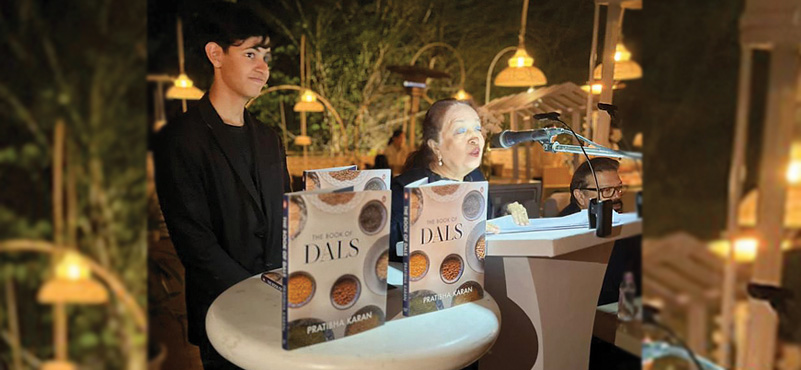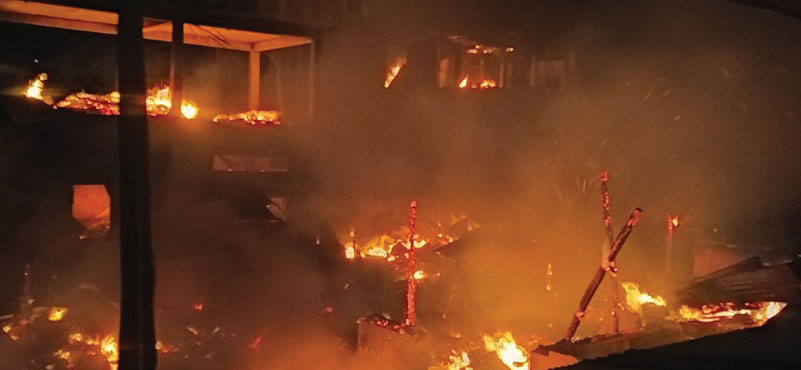Our everyday ‘Dal” has much variety to offer; Browse through this newly launched ‘The Book on Dals’
“The Book on Dal’ was launched at The Olive, at an evening function, hosted by AD Singh over a magical venue, making the affair most memorable. On the occasion, where Vir Sanghvi was the chief guest, others who spoke included Habib Rehman, the legendary hotelier and former US ambassador to India, Peter Burleigh.
Take this incredible journey, through the different regions of our country, hat the routine ‘dal’ means in every other nook. Find lentils in coconut milk, katachi amti and moon sprouts in Maharashtra, dhansak as a Parsi dish in western India, chana dal in Bengal and rajma dal in the north. The book is published by Penguin, authored by former bureaucrat Pratibha Karan, and was released at a function at The Olive, magically hosted by none other than its founder A D Singh. The ceremony was most ably anchored by Azaan, the author’s grandson, a first timer at this task who took up the challenge only that afternoon.
 Both AD Singh and Vir Sanghvi, the chief guest, extolled their relationship with the Karan family, headed by former Police Commissioner of Delhi and former CBI chief, Raja Vijay Karan; their daughters Gauri and Nainika, the leading fashion designers and Gaurav Karan, who heads the Crayon Art gallery. Theirs has been a long association with them, both were delighted to be there on this occasion, being the third book by the author – her first was on Hyderabadi cuisines and the other on Biryani.
Both AD Singh and Vir Sanghvi, the chief guest, extolled their relationship with the Karan family, headed by former Police Commissioner of Delhi and former CBI chief, Raja Vijay Karan; their daughters Gauri and Nainika, the leading fashion designers and Gaurav Karan, who heads the Crayon Art gallery. Theirs has been a long association with them, both were delighted to be there on this occasion, being the third book by the author – her first was on Hyderabadi cuisines and the other on Biryani.
Speaking on the occasion, Pratibha recalled her childhood, when as a young girl in school, her father, who was an engineer was posted in Bilaspur, Himachal Pradesh. She remembered coming home with her school friends and would find her mother making hot Urad dal pinnies full of nuts and pure ghee. They would all attack them and devour them while they were so hot that they could hardly be held in one’s hand. That much for Urad Dal. She went on to narrative her understanding of the variety of dals:
“Dals have been essential part of human diet for centuries. Lentils and pulses are broadly referred to as Dals in Hindi.
Lentils are used throughout the world, South Asia, West Asia and the Mediterranean region. They are used in salads and stews. They are used as just lentils or in conjunction with meat, vegetables and herbs etc. A lentil and rice dish in Arab countries is known as Mujadarra. A similar dish called Kushariis in Egypt is considered one of the two national dishes.
Lentils are used to prepare an inexpensive and nutritious soup all over the Europe and sometimes north and south America, sometimes combined with some chicken or pork. In Mexico dishes are made with kidney beans and minced meat.
Lentils or dals are an integral part of Indian cuisine. And each region according to its taste and availability of ingredients makes dal by adding fish, meat, coconut milk, cream vegetables herbs and a host of aromatic spices.
A simple khichri is a breeze to make. And just enticing are the spicy and tantalising preparations.
Though there is a large variety of dals to choose from, the number of dals and dal based dishes that can be made with them is phenomenal and mind-boggling.
 In our family, every one’s threshold for chillies is high – it goes through the roof. That is what attracted us to go to China, not once but twice. First to Changsha in Hunan province and then to Chengdu in Sichuan province. Both Hunan and Sichuan Food are high in chillies. It was in Chengdu that we met Vir Sanghvi. When we told about the book of dals, that I was writing, he graciously offered to write a blurb for the book.
In our family, every one’s threshold for chillies is high – it goes through the roof. That is what attracted us to go to China, not once but twice. First to Changsha in Hunan province and then to Chengdu in Sichuan province. Both Hunan and Sichuan Food are high in chillies. It was in Chengdu that we met Vir Sanghvi. When we told about the book of dals, that I was writing, he graciously offered to write a blurb for the book.
My husband, Vijay Karan belongs to Hyderabad and Hyderabadi dishes have a sparkling and lively quality. During one of our visits to Hyderabad I remember asking my mother-in-law for more and more recipes till she would tire of me and tell me ‘Ab bas karo – mujhe radio sunne do’. Some dishes to bowl you over include Khatti Dal, Lassan aur Lal Mirch ki Dal and gutsily flavoured Mutton Dalcha with drumsticks Telengana Sambar is a tantalising experience.
Southern states are known for the wide range of spices, such as chillies tamarind, clove cardamom, and pepper. Curry leaves, coconut and drumsticks are used in abundance. Whenever we were posted, I always planted 1 or 2 drumsticks trees in our garden. A drumstick tree in bloom looks ever so beautiful – like a Chinese painting – a joy to behold.
Some amazing dals from Tamil Nadu in the book include Mixed Dal Rassam, Arhar Dal with Vegetables and Payasam Kootu, a medley of vegetables, cooked with lentils, and spices is common across communities in Tamil Nadu, Kerala and Karnataka. A famous and traditional recipe from Karnataka Bisi Bele Huliya a finds place in the book.
With its lush tropical land and tranquil backwaters, Kerala abounds in spices. Muslims, Jews and Christians come in search of spices and many settled in the state. Included in the Kerala section are some truly flavourful recipes – A Spice Flavoured Kerala Dal, Masoor Dal and Bitter Gourd Theeyal and Muringeka Theyal.
Maharashtra is known for its use of Kokum, tamarind, jaggery and coconut. From Mahrashtra we have lentils in Coconut Milk, Katachi Amti and Moong Sprouts etc. There is Dhansak, one of the best known Parsi dishes from Gujarat and Chana Dal Bengal style.
Then again the book is not limited by borders, and includes some lovely dishes from Nepal, Sindh, now in Pakistan and Sri Lanka.
It was during a holiday trip to Sri Lanka that we made a halt at Galle. We stayed at the most beautiful beach villa called ‘Iindisch’ where we had the entire Villa and it’s staff at our disposal. We were fortunate to be treated to meal after meal of Sri Lankan delicacies and fresh coconut water straight from the garden. it was there that I learnt two recipes, Sri Lankan coconut lentils and Sri Lankan Parippu Hodi, both included in the book.
Soups are favourite of my daughter Gauri. The book has some delicious dal based best soups too.
As I said cooking is a creative art. You can seize upon the most immediately available ingredients and it can work gloriously.
As I have always said, say damn, never say die. Cook with confidence, and serve with aplomb, triumphantly.
Good food fills the dining room with laughter, smiles and great joy.”
ABOUT THE AUTHOR
 Pratibha Karan is a retired IAS officer, who has held several positions at the centre. Authored several books, including one on Hyderabadi cuisine, she is the wife of Vijay Karan, former Commissioner Police of Delhi and former CBI director.
Pratibha Karan is a retired IAS officer, who has held several positions at the centre. Authored several books, including one on Hyderabadi cuisine, she is the wife of Vijay Karan, former Commissioner Police of Delhi and former CBI director.




































